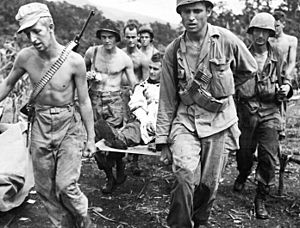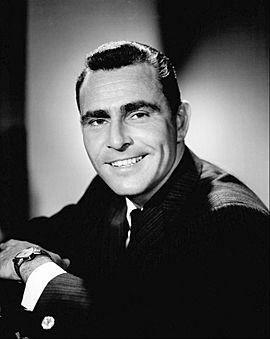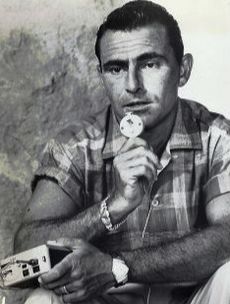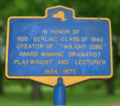Rod Serling facts for kids
Quick facts for kids
Rod Serling
|
|
|---|---|
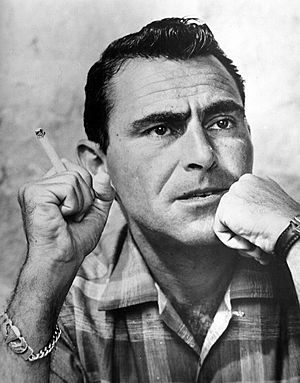
Publicity photo of Serling, 1959
|
|
| Born | Rodman Edward Serling December 25, 1924 Syracuse, New York, U.S. |
| Died | June 28, 1975 (aged 50) Rochester, New York, U.S. |
| Resting place | Lake View Cemetery Interlaken, New York, U.S. |
| Occupation |
|
| Education | Antioch College (B.A. in Literature) |
| Genre | Drama, speculative fiction, science fiction, horror fiction |
| Years active | 1946–1975 |
| Notable works |
|
| Notable awards |
|
| Spouse |
Carolyn Louise Kramer
(m. 1948) |
| Children | 2 |
| Relatives | Robert J. Serling (brother) |
Rodman Edward Serling (December 25, 1924 – June 28, 1975) was an American writer and producer. He is best known for creating the famous TV show The Twilight Zone. Serling also wrote many live TV dramas in the 1950s. He was involved in politics and helped set rules for the TV industry. People called him the "angry young man" of Hollywood. He often disagreed with TV bosses about things like censorship, racism, and war.
Contents
Rod Serling's Early Life
Serling was born on December 25, 1924, in Syracuse, New York. His family was Jewish. He was the second son of Esther and Samuel Lawrence Serling. His father worked as a grocer and later a butcher. Rod had an older brother named Robert, who became a writer too.
The Serling family moved to Binghamton, New York in 1926. Rod's parents encouraged his creative side. His father even built a small stage in their basement. Rod loved to act out stories from magazines and movies. His brother remembered that Rod would talk nonstop for hours.
In elementary school, Rod was known as a class clown. Many teachers thought he wouldn't do well. But his seventh-grade English teacher, Helen Foley, saw his talent. She encouraged him to join public speaking groups. He became part of the debate team and spoke at his high school graduation. He also wrote for the school newspaper. There, he became known for speaking up about social issues.
Rod enjoyed sports, especially tennis and table tennis. He tried to join the football team, but he was too small. He was only 5 ft 4 in (163 cm) tall.
From a young age, Serling loved radio and writing. He listened to thrillers, fantasy, and horror shows. He even tried writing for a local radio station. He was accepted into college after high school. But World War II was happening, so he decided to join the army instead. His civics teacher told him to wait until graduation. "War is temporary," his teacher said. "Education isn't."
Military Service in World War II
Rod Serling joined the U.S. Army right after graduating from Binghamton High School in 1943. His brother Robert had also joined.
Serling started his military training in Georgia in 1943. He joined the 511th Parachute Infantry Regiment of the 11th Airborne Division. He became a Technician Fourth Grade (T/4).
During his paratrooper training, Serling boxed to release stress. He had 17 fights as a flyweight. He often got his nose broken.
On April 25, 1944, Serling learned he was going to fight in the Pacific. He was disappointed because he wanted to fight against Hitler in Europe. In May, he was sent to New Guinea and the Philippines.
In November 1944, his division fought for the first time in the Philippines. They were used as light infantry during the Battle of Leyte. Serling was later moved to the demolition platoon. This group was called "The Death Squad" because many soldiers were injured or killed.
Serling's time in Leyte greatly influenced his writing. He saw death every day. This included a friend, Melvin Levy, who was killed by a falling food crate. Serling led Levy's funeral and placed a Star of David on his grave. The unpredictability of death became a common theme in his stories. In a Twilight Zone episode, he wrote about soldiers in combat. He described their faces as a mix of earth, dust, blood, and fear.
Serling was wounded twice in Leyte, including in his kneecap. But he continued to fight. On February 3, 1945, his unit landed on Tagaytay Ridge and marched into Manila. They faced strong resistance from Japanese troops. During the Battle of Manila, Serling's unit fought block by block.
During a party held by civilians, Serling's group was attacked. Many soldiers and civilians died. Serling, still a private, ran into the gunfire to rescue a performer. His regiment had a 50% casualty rate. Serling was wounded by shrapnel from an anti-aircraft gun. He was sent to New Guinea to recover.
Serling's last assignment was as part of the forces occupying Japan. He received the Purple Heart, the Bronze Star, and the Philippine Liberation Medal. His combat experiences gave him nightmares and flashbacks for the rest of his life. He said he turned to writing to deal with his feelings.
Life After the War
After leaving the Army in 1946, Serling worked at a hospital. He was recovering from his war wounds. His knee bothered him for many years.
He used his military benefits to enroll in Antioch College in Ohio. He first studied physical education. But his interests soon led him to the theater and broadcasting. He changed his major to Literature and earned his degree in 1950. He said he was "mixed up and restless" and liked Antioch's work-study program.
At Antioch, Serling became very active in the campus radio station. This experience helped him later in his career. He wrote, directed, and acted in many radio shows. He met Carolyn Louise "Carol" Kramer, who became his wife. They married on July 31, 1948, and had two daughters, Jodi and Anne.
For extra money, Serling tested parachutes for the U.S. Army Air Forces. He earned good money for successful jumps. He even earned $1,000 for testing a jet ejection seat that had been very dangerous.
Rod Serling's Career
Starting in Radio
In 1946, Serling volunteered as an actor and writer at a radio station in New York. The next year, he worked there as a paid intern. He then took other jobs at radio stations in New York and Ohio. He learned how to write for a medium measured in seconds.
At Antioch College, Serling managed the campus radio station. He created many full-scale radio productions. He wrote, directed, and acted in them. Almost all the shows he created were his original work.
While in college, Serling won his first writing award. He won $500 and a trip to New York City for his radio script "To Live a Dream." He and his wife attended the awards ceremony in 1949.
After college, Serling worked as a writer for WLW radio in Cincinnati. He also sold freelance scripts. The radio industry had many lawsuits, which made it hard for new writers. Serling's scripts were often rejected.
One of his boxing stories was rejected by a show for women listeners. The producer suggested he try television instead. Serling's lighter script, Hop Off the Express and Grab a Local, became his first nationally broadcast piece in 1949.
Serling believed radio was not reaching its full potential. He felt it had become "cheap and unbelievable." He thought very few radio writers would be remembered for their work.
Moving to Television
Serling moved from radio to television, working for WKRC-TV in Cincinnati. He wrote commercials and scripts for a comedy duo. He also created a series of scripts for a live TV show called The Storm. He spent his evenings writing, sending many manuscripts to publishers. He received forty rejection letters in his early years.
In 1950, Serling hired an agent. His radio scripts were still rejected, so he rewrote them for television. Many found a home in either radio or TV. He eventually left WKRC to become a full-time freelance writer. He said writing was a "demanding profession" that he "succumbed to."
In early 1953, Serling and his family moved to Connecticut. He wrote for live drama shows like Kraft Television Theatre and Hallmark Hall of Fame. By late 1954, his agent told him to move to New York, "where the action is."
A writer named Marc Scott Zicree said that Serling's stories always tried to find "emotional truth." They tried to make a statement about the human condition.
Becoming Famous
In 1955, Kraft Television Theatre aired Serling's 72nd script, "Patterns". Serling missed the first live broadcast. But after it aired, his phone started ringing and "didn't stop for years!" The show changed his life.
"Patterns" was about a power struggle in a company. An older boss was losing his touch, and a bright young executive was being trained to replace him. The boss tried to get rid of his competition. Serling based the boss character on his old military commander.
Critics loved "Patterns." The New York Times called it "one of the high points in the TV medium's evolution." The show was so popular that a second live broadcast was done a month later.
After "Patterns," Serling received many job offers. He sold many of his older, less-polished works. Critics worried he wasn't living up to his promise. But then he wrote "Requiem for a Heavyweight" in 1956 for Playhouse 90, which also received great praise.
In 1957, the Serling family moved to California. As TV shows started being taped instead of live, the business moved west. The Serlings lived in California for most of Rod's life. But they kept homes in Binghamton and Cayuga Lake for quiet getaways.
Fighting Censorship
In the early days of television, sponsors often acted as editors. Serling was often forced to change his scripts. Sponsors worried about anything controversial. They removed references to social issues or anything that might compete with their products. For example, a reference to the Chrysler Building was removed from a script sponsored by Ford.
Serling was frustrated by this. He decided the only way to avoid this was to create his own show. He told an interviewer that he didn't want to "fight anymore." He wanted to put on controversial themes without having to compromise.
Serling sent "The Time Element" to CBS. He wanted it to be the pilot for his new show, The Twilight Zone. Instead, CBS used it for another show, Westinghouse Desilu Playhouse, in 1958. The story was about a man who had vivid nightmares about the attack on Pearl Harbor. The ending revealed that the man had died at Pearl Harbor. The episode was very popular. This led CBS to agree to let Serling create The Twilight Zone.
The Twilight Zone
The Twilight Zone, created by Serling, first aired on CBS on October 2, 1959.
Serling fought hard to control the show's creative direction. He hired talented writers like Richard Matheson and Charles Beaumont. He believed the science fiction format would help avoid censorship.
Many episodes drew from Serling's own life. These included stories about boxing, military life, and pilots. The Twilight Zone also explored his social views on race relations. Sometimes, the message was very clear. For example, in "I Am the Night—Color Me Black", hatred caused a dark cloud to spread across a town. Many stories also showed his views on gender roles.
The Twilight Zone ran for five seasons. It won many awards and received critical praise. Even though it had loyal fans, its ratings were only moderate. It was canceled and brought back twice. After five years and 156 episodes, Serling was tired of the series. He decided not to fight its final cancellation in 1964.
Serling sold the rights to The Twilight Zone to CBS. His wife said he did this because his own company often went over budget.
The Twilight Zone has been brought back many times. There was a film in 1983 and three new TV series. These aired in 1985, 2002, and 2019.
Night Gallery
In 1969, NBC aired a pilot film for a new series called Night Gallery. Serling wrote it and hosted the show. He played a museum curator who introduced three scary stories. The series focused more on horror and suspense than The Twilight Zone.
Serling chose not to have full creative control over Night Gallery. He later regretted this. He disliked the short comedic sketches that were added to the show. He felt they didn't fit with the serious horror themes. Serling still wrote many scripts for the series. But by the third season, many of his ideas were rejected or changed. Night Gallery was canceled in 1973.
Other TV Work
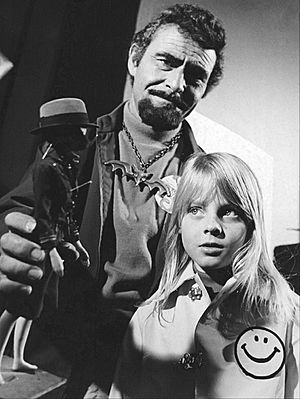
After The Twilight Zone, Serling wrote a western TV series called The Loner. It ran from 1965 to 1966. CBS wanted more action, but Serling refused to change it.
In 1969, Serling hosted the game show Liar's Club. In the 1970s, he appeared in commercials for car companies. He also acted in a few shows he didn't write. He played "Mr. Zone" on The Jack Benny Program and a small role in an Ironside episode with a young Jodie Foster.
Teaching Career
Serling kept a very busy schedule. When he wasn't writing or producing, he often spoke at colleges. He taught week-long seminars where students watched and discussed films. He felt a strong connection to older students in his evening classes.
During the fourth season of Twilight Zone, Serling was tired. He let other writers handle most of the episodes. He took a year off to teach at Antioch College. He taught classes on writing and drama. He also worked on a new screenplay, Seven Days in May.
Later, he taught at Ithaca College until his death in 1975. He was also a guest teacher at Sherwood Oaks Experimental College in Hollywood. Recordings of his lectures are available on some Twilight Zone home videos.
Important Themes in Serling's Work
Serling's wife, Carol, said he often said that "the ultimate obscenity is not caring." This idea is seen throughout his writing. Many of his stories deal with war, politics, and equality for all people.
Speaking Out Against War
Serling's experiences as a soldier deeply affected him. He became a strong antiwar activist, especially during the Vietnam War. He supported politicians who were against the war.
"The Rack" is an example of how Serling used TV to share his political views. This script was about an army captain accused of working with the enemy. Serling explored the question of whether veterans should be charged with crimes if they cooperated under pressure. The story offered strong arguments for both sides. The captain was found guilty, but Serling left the audience to form their own opinions.
Promoting Racial Equality
A Town Has Turned to Dust received positive reviews. One critic called it "a raw, tough and at the same time deeply moving outcry against prejudice." The story is set in a drought-stricken town. Poverty and despair lead to deadly racial tensions against Mexican residents. The sheriff tries to stand strong, and a Mexican boy is saved. Serling showed that hatred leads to destruction.
Serling also wrote the 1972 film The Man. It was based on a novel where a Black senator becomes the U.S. president.
Rod Serling's Death
Serling was a heavy smoker, smoking three to four packs of cigarettes a day. On May 3, 1975, he had a heart attack and was hospitalized. Two weeks later, he had another heart attack. Doctors decided he needed open-heart surgery. The surgery was performed on June 26, but Serling had a third heart attack during the operation. He died two days later, on June 28, 1975, at the age of 50.
His funeral and burial were on July 2 at Lake View Cemetery in Interlaken, New York. A memorial was held at Cornell University on July 7, 1975. His daughter Anne spoke at the memorial. His wife, Carol, died on January 9, 2020, and was buried next to him.
Rod Serling's Legacy
Serling began his career when television was very new. Commercial television officially started in 1941. But World War II put the business on hold. After the war, money flowed into TV. Serling is credited as one of the first to write scripts specifically for television. He helped make TV drama a respected art form.
Serling worried that TV would decline like radio. He encouraged sponsors to see TV as a way to address important social issues. He disliked how commercial breaks interrupted dramas. He felt that art should not be controlled by people who only cared about selling goods. Serling helped shape the future of television throughout his career.
Writing for Different Media
Serling was one of the first writers to work in both television and movies. He turned his TV successes, "Patterns" and "The Rack," into full-length films. Before this, many writers didn't want to write for TV. Shows were often only shown once and then stored away.
The Start of Reruns
After "Patterns" first aired, the studio received so much positive feedback that they showed it again. This was the first time a TV program was replayed because the audience asked for it. This inspired critics to suggest that shows should be seen more than once. "Patterns" proved that a second showing could attract more viewers.
Impact on Popular Culture
Rod Serling is a lasting part of modern popular culture because of The Twilight Zone. His widow, Carol, said that the show's lasting popularity was a surprise, even to him. She continued to promote his legacy after his death.
The Twilight Zone has been rerun, remade, and reimagined many times. It has been turned into comic books, a magazine, a film, and three more TV series.
Some of Serling's works are now available as graphic novels. Rod Serling's The Twilight Zone is a series of adaptations based on his original scripts. Serling himself adapted several episodes into books.
In 1994, Rod Serling's Lost Classics released two of his never-before-seen works. Carol Serling found them in her garage. One was an outline that another writer expanded. The other was a complete script by Serling.
Serling and The Twilight Zone inspired the Disney theme park ride The Twilight Zone Tower of Terror. It opened in Florida in 1994. Serling appears in the ride through old footage and a voice actor. The ride takes guests on a mysterious elevator journey in a haunted hotel.
Since 1995, Binghamton High School, Serling's old school, hosts the Rod Serling Video Festival. It encourages young people to make films.
In 2005, Serling was digitally brought back for an episode of the TV series Medium. He introduced the episode using old footage and new voice acting. In 2009, the United States Postal Service released a stamp honoring The Twilight Zone and featuring Serling.
In 2019, a simulated version of Serling appeared in the "Blurryman" episode of the new Twilight Zone revival.
Images for kids
-
Ed Begley, Everett Sloane and Richard Kiley in Patterns (1955)
-
Sam Jaffe and Jack Albertson in Serling's 1976 posthumous television special "The Sad and Lonely Sundays", an episode of the abandoned series The Oath
Selected Works
Filmography
- 1953: Old MacDonald Had a Curve (Kraft Television Theatre)
- 1955: Patterns (Kraft Television Theatre)
- 1955: The Rack (The U.S. Steel Hour)
- 1956. Patterns
- 1956: The Arena (Studio One)
- 1956: Requiem for a Heavyweight (Playhouse 90)
- 1957: The Comedian (Playhouse 90)
- 1958: Bomber's Moon (Playhouse 90)
- 1958: A Town Has Turned to Dust
- 1958: Saddle the Wind
- 1958: The Velvet Alley
- 1959–64: The Twilight Zone (TV series)
- 1960: The Man in the Funny Suit
- 1962: Ichabod and Me (actor, episode "The Celebrity" as Eugene Hollinfield)
- 1962: Requiem for a Heavyweight (film adaptation)
- 1963: The Yellow Canary
- 1964: Seven Days in May
- 1964: A Carol for Another Christmas (TV film)
- 1965–66: The Loner (TV series)
- 1966: The Doomsday Flight (TV film)
- 1968: Planet of the Apes (co-written with Michael Wilson)
- 1968–75: The Undersea World of Jacques Cousteau (TV series; narrator)
- 1970–73: Night Gallery (TV series)
- 1972: The Man (story and screenplay)
- 1972: Ironside (actor, episode "Bubble, Bubble, Toil, and Murder")
- 1973: Encounter with the Unknown (narrator)
- 1974: UFOs: Past, Present, and Future (documentary)
- 1974: Phantom of the Paradise (narrator)
- 1994: Rod Serling's Lost Classics (posthumously released telefilm)
- 2000: A Storm in Summer (1970 Screenplay)
Books
- Patterns: Four Television Plays, Bantam, 1957
- Stories from the Twilight Zone, Bantam (New York City), 1960
- More Stories from the Twilight Zone, Bantam, 1961
- New Stories from the Twilight Zone, Bantam, 1962
- From the Twilight Zone, Doubleday (Garden City, NJ), 1962
- Requiem for a Heavyweight: A Reading Version of the Dramatic Script, Bantam, 1962
- Rod Serling's Triple W: Witches, Warlocks and Werewolves; A Collection,(Editor) Bantam, 1963
- The Season to Be Wary (3 novellas), Little, Brown (Boston, MA), 1967
- Devils and Demons: A Collection, Bantam, 1967 (Editor and author of introduction)
- Night Gallery, Bantam, 1971
- Night Gallery 2, Bantam, 1972
- Rod Serling's Other Worlds,(Editor) Bantam, 1978
Awards and Honors
Rod Serling won many awards for his writing and television work.
- He won several Emmy Awards for his teleplays, including for Patterns, Requiem for a Heavyweight, and The Comedian.
- He also won a Peabody Award for Requiem for a Heavyweight.
- In 1962, he won a Golden Globe Award for The Twilight Zone.
- In 1985, he was inducted into the Television Hall of Fame.
- He has a star on the Hollywood Walk of Fame.
- In 2007, TV Guide ranked him No. 1 on its "25 Greatest Sci-Fi Legends" list.
- In 2008, he was inducted into the Science Fiction Hall of Fame.
See also
 In Spanish: Rod Serling para niños
In Spanish: Rod Serling para niños


